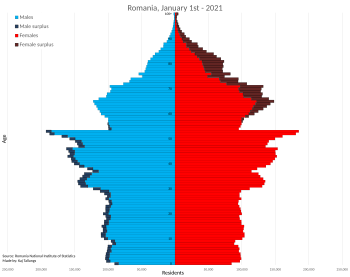
Back التركيبة السكانية في رومانيا Arabic Насельніцтва Румыніі Byelorussian Население на Румъния Bulgarian Obyvatelstvo Rumunska Czech Demografie Rumäniens German Demografía de Rumania Spanish Romanian väestö Finnish Démographie de la Roumanie French Demografía de Romanía Galician Románia népessége Hungarian
| Demographics of Romania | |
|---|---|
 Population pyramid of Romania as of 2021 | |
| Population | |
| Density | 83.4/km2 (216/sq mi) |
| Growth rate | |
| Birth rate | |
| Death rate | |
| Life expectancy | |
| • male | |
| • female | |
| Fertility rate | 1.71 children born/woman (2022)[2] |
| Infant mortality rate | 5.6 deaths/1,000 live births (2023)[3] [4] |
| Net migration rate | −0.24 migrants/1,000 population (2015) |
| Age structure | |
| 0–14 years | 3,073,902 (16.1%) |
| 15–64 years | 12,253,533 (64.3%) |
| 65 and over | 3,726,380 (19.6%) |
| Sex ratio | |
| Total | 0.95 males/female (2014) |
| At birth | 1.06 males/female |
| Under 15 | 1.05 males/female |
| 15–64 years | 1.02 males/female |
| 65 and over | 0.73 males/female |
| Nationality | |
| Nationality | noun: Romanian(s), adjective: Romanian |
| Major ethnic | Romanian |
| Minor ethnic | Hungarian, Roma, Ukrainian, German, Turkish, Tatar, Russian, Lipovan, Serbian, Slovak, Czech, Polish etc. |
| Language | |
| Official | Romanian |
| Spoken | Romanian and other minority languages |
Demographic features of the population of Romania include population density, ethnicity, education level, health of the populace, economic status, religious affiliations, and other aspects of the population.
About 89.3% of the people of Romania are ethnic Romanians (as per 2021 census), whose native language, Romanian, is an Eastern Romance language, descended from Latin (more specifically from Vulgar Latin) with some French, German, English, Greek, Italian, Slavic, and Hungarian borrowings.
Romanians are by far the most numerous group of speakers of an Eastern Romance language today. It has been said that they constitute "an island of Latinity"[5] in Eastern Europe, surrounded on all sides either by Slavic peoples (namely South Slavic and East Slavic peoples) or by the Hungarians. The Hungarian minority in Romania constitutes the country's largest minority, or as much as 6.0 per cent of the entire population.[6] With a population of about 19,659,267 people in 2022, Romania received 989,357 Ukrainian refugees on 27 May 2022, according to the United Nations (UN).[7]
The 2022 Russian invasion of Ukraine that began on 24 February 2022 triggered a major refugee crisis in Europe.[8] In connection with the Russian invasion of Ukraine on 24 February 2022, as part of the Russian-Ukrainian war, by 15 May 2022, more than 6,223,821 Ukrainian refugees left the territory of Ukraine, moving to the countries closest to the west of Ukraine, of which more than 919,574 people fled to neighbouring Romania.[7]
- ^ "Populația rezidentă la 23 martie 2023" [Resident population as of March 23, 2023]. insse.ro (in Romanian). Institutul Național de Statistică. Retrieved 23 March 2023.
- ^ "World Population Dashboard – Romania".
- ^ "Infant Mortality Rate by Country 2023".
- ^ "Infant mortality rate – the World Factbook".
- ^ See, for example, Fabio Bordignon, "Italian Decentralisation in Romania", SEF 2003, Warsaw. Abstract available online. Archived 2007-09-26 at the Wayback Machine
- ^ "COMUNICAT DE PRESĂ : 2 februarie 2012 privind rezultatele provizorii ale Recensământului Populaţiei şi Locuinţelor" (PDF). Recensamantromania.ro. 2011. Archived from the original (PDF) on 2 August 2019. Retrieved 3 October 2017.
- ^ a b "Refugees fleeing Ukraine (since 24 February 2022)". UNHCR. 2022.
- ^ "Situation Ukraine Refugee Situation". UNHCR. Retrieved 24 March 2022.
© MMXXIII Rich X Search. We shall prevail. All rights reserved. Rich X Search